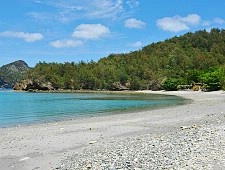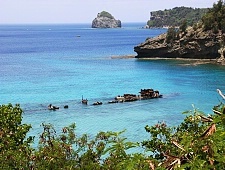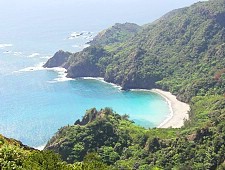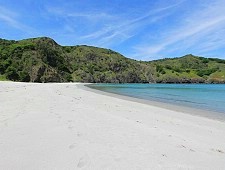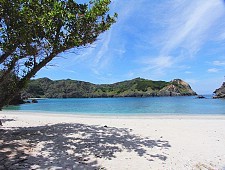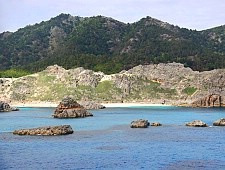Chichijima Island
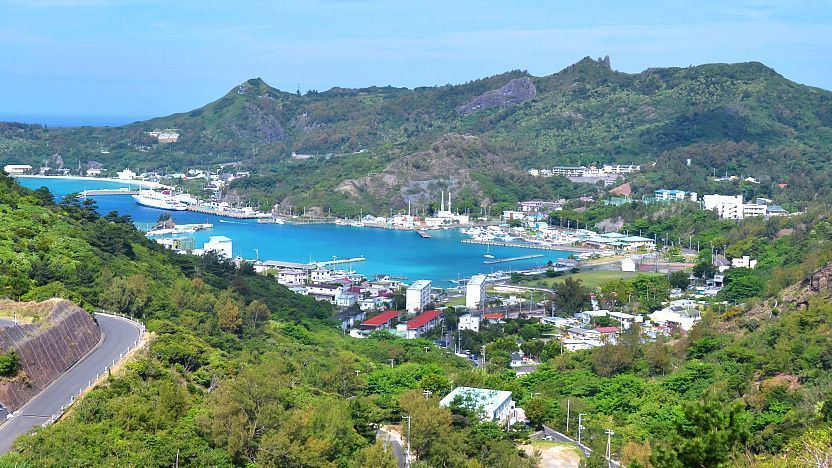
Chichijima Island (父島, Father Island) is the largest of the Ogasawara Islands. The mountainous island is covered in subtropical forest, white sand beaches and rocky cliffs. The remoteness and natural beauty of the island's green forests and deep blue oceans, combined with a relaxed island character make Chichijima a perfect place to escape from the speed of modern life.
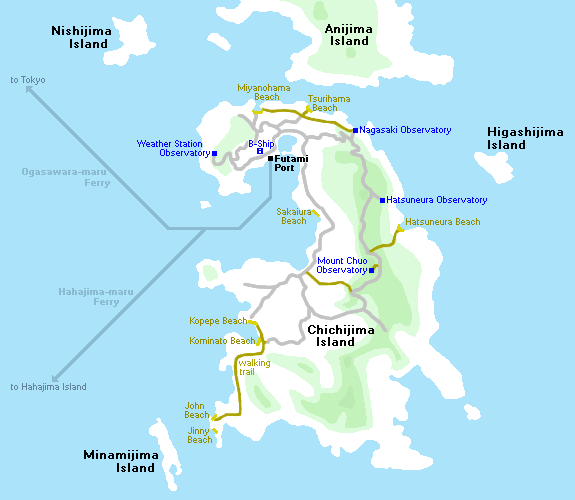
After the long ferry ride from Tokyo, all visitors to the Ogasawara Islands arrive at Futami Port in the north of Chichijima. The port is surrounded by the only major village on the islands where most hotels, pensions, shops and restaurants are located. There you will also find the B-Ship tourist information office, where reservations for outdoor activity tours can be made.

Tours around the islands are mainly conducted in Japanese, however there are a few tour operators that can provide English speaking guides. The Ogasawara Village Tourist Association provides a helpful English guide map that lists all of the island's licensed guides and tour companies, and specifies their level of English and whether or not they accept credit cards.
Chichijima Island is popular for whale and dolphin watching. Humpback whales are frequently viewed between February and April, while sperm whales are often seen from July to September. Bottlenose Dolphins and Spinner Dolphins are found year round around the islands, and it is possible to swim with them or see them swim alongside boats. Half day (around 8,000 yen) and full day (around 13,000 yen) tours can be arranged at the B-Ship tourist information office or directly through tour operators.

Punctuating Chichijima's rocky coastline are many picturesque beaches that feature clear blue water for sunbathing, swimming and snorkeling. The best season for beach activities and snorkeling is from June to October when the air temperature consistantly tops 25 degrees.
Some of the best beaches on Chichijima include:
Various other ocean activities, including scuba diving, sea kayaking, fishing, surfing, bodyboarding and windsurfing, can also be enjoyed in the waters off Chichijima Island. Inquire at B-Ship or directly through tour companies for more information on organized tours.
Chichijima also offers a network of trails and observation points across its mountainous interior, offering dramatic views over the island, cliffs and surrounding smaller islands. Some of the best observation points are the Weather Station Observatory near Futami Port, known for its sunsets and the possibility to spot humpback whales in winter, and the Mount Chuo Observatory with a 360 degree view. Among the wildlife to be spotted are endemic birds as well as introduced wild goats.

One of the most beautiful attractions around Chichijima is Minamijima Island (南島, South Island), located about one kilometer southwest of Chichijima. This small uninhabited island is home to many indigenous animals and plants and is a popular breeding ground for green sea turtles and sea birds. It features a picturesque small bay that is surrounded by a white sand beach and rocky cliffs and is connected to the ocean by a tunnel carved into the cliffside.
To protect Minamijima's fragile ecosystem only a limited number of visitors accompanied by a licensed local guide are allowed to visit each day, and the island is completely closed during winter. Many companies offer tours of the island, typically combined with dolphin swimming and snorkeling for around 9,000 yen (half day) or around 13,000 yen (full day). Reservations can be made at the B-Ship tourist information office or directly through tour companies.

Chichijima has a small but interesting range of restaurants and bars around Futami Port. Some of the local specialties include Shimazushi, a nigiri-style sushi made of soya sauce-marinated Spanish Mackerel placed over sweetened rice with karashi mustard instead of wasabi. The adventurous can also try sea turtle, which is served raw, fried or stewed. The island also features a variety of tropical fruit and island tomatoes, as well as passion fruit rum.
To protect the unique natural environment of Chichijima, visitors must pay attention not to import any seeds or alien species to the island and refrain from collecting or otherwise harming the local plants and wildlife. For this reason camping and off-trail hiking are strictly prohibited throughout the island. Visitors are also encouraged to use human power as much as possible to get around the island.

Getting there and around
How to get to Chichijima
The only way to access the Ogasawara Islands is by the Ogasawara-maru Ferry from Tokyo in a 24 hour journey. The ferry departs Tokyo once every six days except during the high seasons when departures are increased to once every three days. The ferry does not operate for two weeks in mid January due to an annual inspection. Ferry departures can be delayed by a day or more when the sea is very rough, for example, due to a typhoon.
The Ogasawara-maru Ferry departs from Takeshiba Pier, next to Takeshiba Station on the Yurikamome or a ten minute walk from Hamamatsucho Station on the Yamanote Line. The boat ride is an adventure in itself. The ferry first travels through Tokyo Bay, offering interesting views of the Rainbow Bridge, Odaiba, Haneda Airport and Yokohama before passing the Izu Islands and then traveling through the night to arrive at Futami Port on Chichijima the next day.

The ferry offers different classes on five decks that range in price from about 30,000 to 90,000 yen per person one way. Fares differ somewhat on the season. The cheapest Economy class fare includes a bedroll in a dormitory room. Higher class cabins consist of semi-private bunks and private rooms, the latter of which include in-room toilets and showers.
The Ogasawara-maru's facilities also include a restaurant, lounge, showers, store, vending machines, hot water dispensers, kids room, smoking room, public phones and small valuables lockers, but there are no large-sized lockers on board. Passengers may also venture outside to the open-air decks of the boat. A tour of the ship's bridge is held each morning.

How to get around Chichijima
Futami Port in the north of Chichijima is the transport hub of the Ogasawara Islands, where the ferries from Tokyo and Hahajima dock. It is surrounded by the only sizable town on Chichijima, where most of the hotels, restaurants, shops and tour companies are located. The town itself is small and walkable.
The main road on the island connects Futami Port with Kominato Beach eight kilometers further south. It is served by an hourly bus that costs 200 yen per ride or 500 yen for a 1-day pass. A secondary road leads through the island's mountainous interior and is not served by public transportation. Hotels and tour companies provide pick up services to their clients. Furthermore, bicycles, scooters and cars can be rented on the island.

Questions? Ask in our forum.
